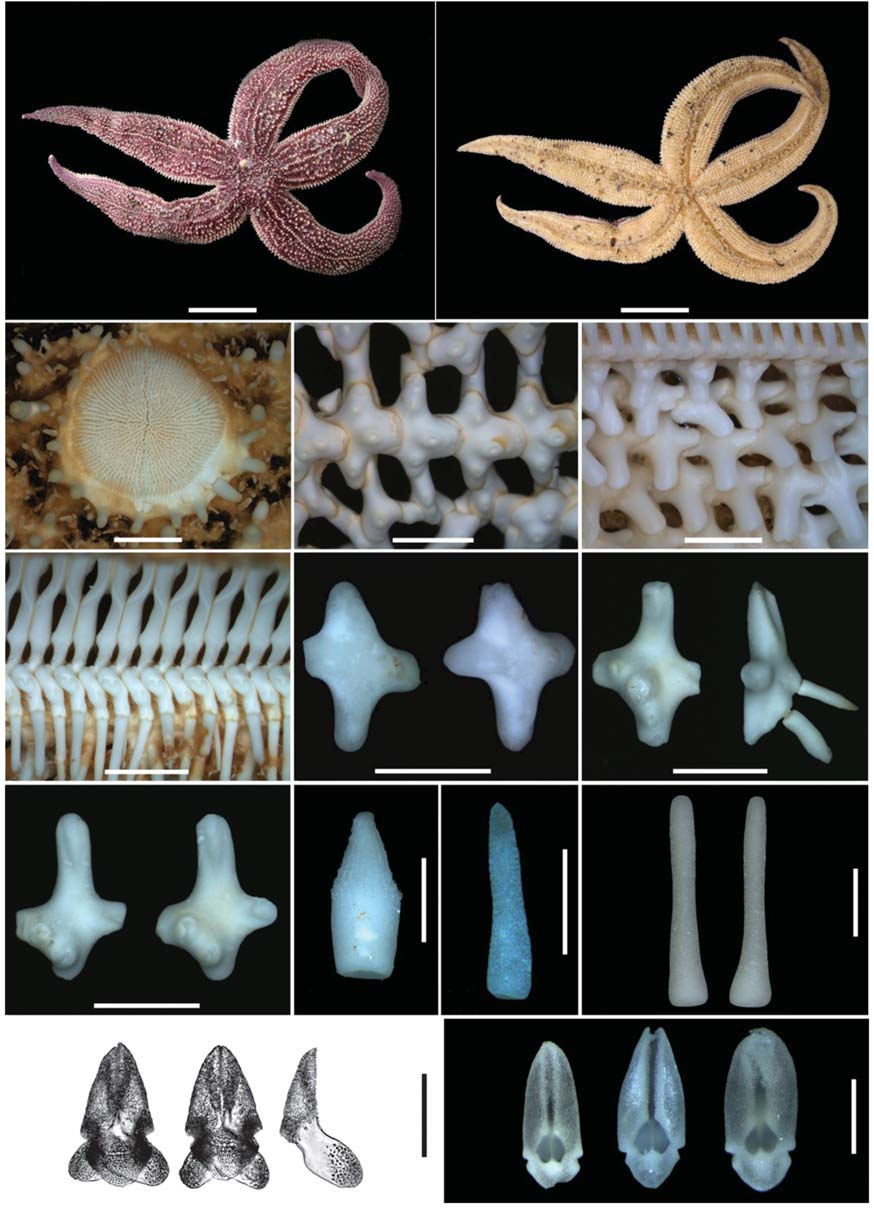



Sea stars were collected with fishing nets between depths of 40-150 m from the Gangwon-do coastal region, East Sea. Specimens were identified as Evasterias echinosoma Fisher, 1926 belonging to the family Asteriidae, which is new to the Korean fauna. This species was characterized by strong external spines and a general size of more than 200 mm, thus the largest sea star identified in Korea to date. Its morphological characteristics are described here with photos. Thirty two asteroid species including E. echinosoma have been reported from the East Sea of Korea.
Asteriidae is the largest family of order Forcipulatida and comprises 221 species within 43 genera worldwide (Mah,2009). In Korea, Asteriidae was composed of 8 species and 7 genera:
Class Asteroidea de Blainville, 1830
Order Forcipulatida Perrier, 1884
Family Asteriidae Gray, 1840
Genus
Key to the Korean species of genus Evasterias
1. Dorsal spines crowded, inferomarginal plates on margin of arm ??????????????????????????????????????????????????????????
- Dorsal spines well spaced, inferomarginal plates and upper side of ventrolateral plates on margin of arm ???????????????????????????????????????????????????????????????????????????????
1*Evasterias echinosomaFisher, 1926 (Fig.1 A-N)
Materials examined. 1 specimen, Sacheon, 11 Aug 2009,Shin S, at 40 m depth; 1 specimen, Geojin, 27 Dec 2009, Lee T, at 80 m depth; 1 specimen, Chodo, 27 Dec 2009, Shin S, at 40 m depth; 3 specimens, 22 Jun 2010, Lee T, at 70m depth; 2 specimens, Geojin, 15 Sep 2010, at 80 m depth; 1 specimen, Imwon, 17 Sep 2010, Lee T, at 40 m depth; 1 specimen, Daejin, 17 Oct 2010, Shin S, at 80 m depth; 1 specimen, Geojin, 17 Oct 2010, Lee T, at 110 m depth; 1 specimen, Jangho, 26 Dec 2010, Shin S, at 150 m depth.
Description. R=214-252 mm, r=34-41 mm, R=6.2-6.3r.Five arms long and very strong, somewhat depressed in basal part, one-fifth of arm the widest, tapering to tip, depressed towards amburacral groove, dorsal surface convexed and ventral surface almost flattened. Dorsal skeleton irregularly mesh form, composed with three or four lobed large primary plate and small atypical second plates. Carinal plate four lobed, arranged in a longitudinal series, usually with three spines in a plate consisting of two slender spines and one larger strong spine. Two types of dorsal spines located:larger strong spine apart from each other, uniformly sized,subconical shaped, usually one in a plate and slender spine finger shaped, usually two in a plate. Madreporite large, distinctly circular, flattened, situated nearby margin of disk.Marginal plates longitudinal four lobed, regularly arranged in two longitudinal series, similar size and adjacent to ventrolateral plates. As superomarginal plate located in dorsolateral side, inferomarginal plate defined margin of arm. Superomarginal plate usually with one spine, but often two at proximal part of arm, each spine a little longer, stronger and more tapered than dorsolateral spine, and encircled by crossed pedicellariae. Inferomarginal spines usually two in a plate, but rarely three, slender ones located in upper side. Ventrolateral plate four lobed, usually arranged in six regular longitudinal series, gradually decreasing in size toward furrow, usually two spines in a plate, but innermost plate have one spine with a tuft of small crossed pediciellariae and a large straight pedicellaria. Adamburacral plate short, broad, round triangle form, with three spines: furthermost spine more slender and shorter than inner spines with blunt tips. Two kinds of straight pedicellariae present: larger one usually unguiculate type with strongly interdigitated apex, usually in dorsal side, rarely in marginal plates and nearby oral spines; large lanceolate one with shallow interdigitated apex and small serrated valve. Smaller one lanceolate type with small serrated valve, usually in dorsal side, adambulacral plates, and oral spines, and rather few in border of amburacral and adamburacral plates. Small crossed pedicellariae very numerous, located singly or in a group in dorsal side, and marginal,ventrolateral and oral parts. Color in life burgundy in dorsal side, almost white in dorsal spines, orange in madreporite, and dark yellow in ventral side.
Distribution. Korea (East Sea), Avatka Bay, Kamchatka-Okhotsk Sea, southern Bering Sea (Bristol Bay-Unalaska).
Remarks.This species is characterized by its large burgundy body covered with numerous strongly short white spines. This was first recorded by Fisher (1926), and then Hayashi (1943), and D’yakonov (1968) collected many specimens in northern Hokkaido, Okhotsk Sea, and Bering Sea, respectively.Six series of ventrolateral plates have been observed in our specimens, but Fisher (1930) usually described five or six series, rarely four, and D’yakonov (1968) usually described five or six series, rarely seven. A number of ventrolateral series seems to be different according to the body size. This species was reported as the largest sea star in marine fauna of Russia (D’yakonov, 1968), and also in Korea.
Korean name: 1*가시그물불가사리 (신칭)
